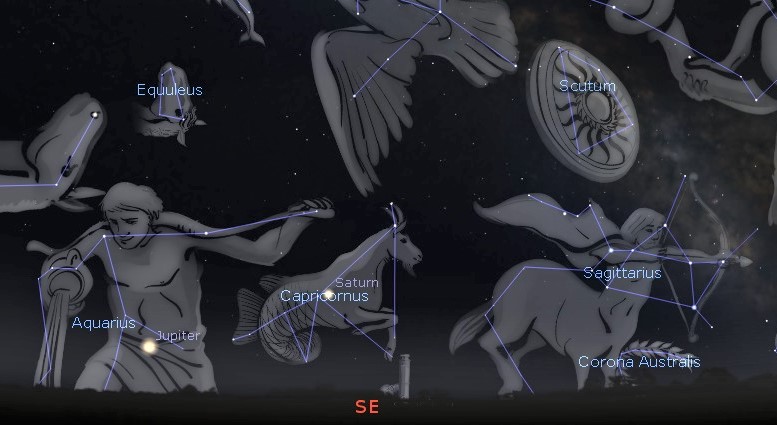This Week’s Sky at a Glance, 2021 June 12 – 19 ~by Curt Nason
It has been said we live in a topsy-turvy world. Actually, we live on one. Earth’s polar axis is tilted to its orbital path around the Sun, leaning just over a quarter of the way from upright to horizontal. At our summer solstice, the north polar axis is tipped toward the Sun and sunlight reaches us at a steep angle with concentrated warmth.
If you note the times of sunrise and sunset over the month you might be surprised to discover the earliest sunrise and latest sunset do not occur on the solstice. Although the most amount of daylight occurs then, we get our earliest sunrise around June 16 and latest sunset around June 26. Earth’s tilt plays a role in that, as does the fact that its orbit is not circular. We are about five million kilometres closer to the Sun in early January than we are in early July. Four centuries ago Johann Kepler showed that planets travel faster when they are nearer the Sun. Have you noticed that the time between the beginning of spring and fall is a week longer than between fall and spring?
We expect the Sun to reach its highest daily position in the sky, crossing the meridian, at midday (noon local standard time, accounting for distance from the centre of our time zone). However, the Sun’s daily north-south movement over the seasons and Earth’s varying speed in orbit make the Sun appear to reach the meridian ahead or behind schedule by as much as 16 minutes. Consequently, our 24-hour clock is based on an annual average noon called mean solar time. Sundial aficionados know they have to account for these daily corrections to agree with the clock.
This Week in the Solar System
Saturday’s sunrise in Moncton is at 5:27 am and sunset will occur at 9:10 pm, giving 15 hours, 43 minutes of daylight (5:35 am and 9:12 pm in Saint John). Next Saturday the Sun will rise at 5:27 am and set at 9:13 pm, giving 15 hours, 46 minutes of daylight (5:36 am and 9:15 pm in Saint John).
The Moon passes above Mars this Sunday and it is at first quarter late Thursday evening, after midnight. Friday evening, the 110 kilometre lunar fault line known as Rupes Recta or the Straight Wall will be visible in a telescope. At midweek, Venus sets around 10:45 pm, followed by Mars 50 minutes later, and within the next hour Saturn and Jupiter will have risen.
With astronomy meetings and outreach activities on hold, you can watch the local Sunday Night Astronomy Show at 8 pm and view archived shows.
Questions? Contact Curt Nason.

